Long read: How Israeli genocidal war turned Gaza’s environment into ticking bomb
By Maryam Qarehgozlou
Israel’s genocidal war against Gaza and its unabated air, land, and sea attacks on the besieged territory, besides killing thousands of civilians, is also taking a heavy toll on the environment.
The situation in Gaza, where more than 39,000 Palestinians have already been killed and nearly 85 percent of its population is internally displaced, is likely to worsen due to environmental degradation.
The protracted environmental challenges the besieged Gaza Strip was facing even before the ongoing war could take decades to reverse and prove extremely costly, according to experts and aid agencies.
Gaza, which in the UN Secretary-General António Guterres’ words has become a “humanitarian hellscape,” had suffered direct war-related damage to the tune of $18.5 billion at the end of January 2024, equivalent to around 97 percent of the total Gross Domestic Product (GDP) of the occupied West Bank and Gaza in 2022, according to the World Bank.
The World Bank report, published in March, revealed that environmental damages are estimated at US$411 million, adversely affecting physical assets such as coastal areas, water, soil, agricultural fields, the Wadi Gaza nature reserve, and vital ecosystem services.
The authors hastened to warn that “the estimated scale of the damages is expected to increase” as the Israeli regime refuses to scale down its military onslaught or agree to a ceasefire.

A preliminary assessment by the UN Environment Programme (UNEP) in June also highlighted growing soil, water, and air pollution and heightened risks of irreversible damage to Gaza’s environment.
The assessment, prepared in response to an official request by the state of Palestine in December last year, showed that the intensive bombardment of Gaza by Israel has led to “unprecedented intensity of destruction in terms of infrastructure, productive assets, and service delivery.”
Key areas of damage, the report noted, include interruption and collapse of sewage, wastewater, and solid waste management systems and facilities, as well as destruction of buildings, infrastructure, and generation of nearly 39 million tons of conflict-related debris.
The Israeli regime's no-holds-barred war on Gaza has also caused extensive damage to the energy, fuel and associated infrastructure, marine, coastal environments and fisheries, terrestrial environments (including soil and cultivated lands), and exacerbated air pollution, the report stated.
The size and lasting impact of the destruction in Gaza have led to growing calls for the Israeli regime to be investigated for “ecocide,” which constitutes a war crime.
Ecocide refers to significant environmental harm caused by intentional or negligent actions. Under the Rome Statute, which governs the International Criminal Court (ICC), it is a war crime to intentionally launch an excessive attack knowing that it will cause widespread, long-term, and severe damage to the natural environment.
“Environmental degradation is worsening already dire humanitarian conditions in Gaza, with numerous short and longer-term implications described in UNEP’s Preliminary Assessment report,” a UNEP spokesperson told the Press TV Website.
“Immediate impacts include spread of communicable diseases, disrupted water and sanitation as well as poor air quality,” the official added.
Gaza’s environmental challenges before ongoing war
Before October 2023, when the Israeli regime launched a devastating war against Palestinians, both the Gaza Strip and the occupied West Bank were already affected by environmental changes.
A UNEP report published in 2020 indicated that the Israeli occupation of Palestine, high population growth accompanied by rapid and poorly planned urbanization, as well as climate change were the main drivers of environmental degradation in the occupied Palestinian territories.
The key findings of the 2020 analysis showed that the depletion of coastal aquifers due to a steady increase in demand and poor water quality caused by the use of agricultural pesticides, along with the leaching of sewage have resulted in a freshwater crisis in Gaza.
Pollution of the marine environment, caused by the flow of untreated or partially-treated water and wastewater into the sea, contamination of soil caused by the discharge of raw and untreated wastewater into the agricultural lands, and the widespread disposal of solid waste in informal dump sites also affected the state of the environment in the Gaza Strip.
However, between 2020 and 2023, Gaza saw more environmental degradation as a result of Israel’s May 2021 onslaught in the territory.
✍️ Conversation -What Israel is doing in Gaza is ‘ecocide’ – destruction of environment: Activisthttps://t.co/JemcD1oW2Y
— Press TV 🔻 (@PressTV) July 22, 2024
How current war affected Gaza's environment
UNEP says the current Israeli war on Gaza has interrupted “almost all” environmental management systems and services and created new environmental hazards.
All sources of water available to Palestinians as well as wastewater treatment and disposal facilities in Gaza have been disrupted by the relentless Israeli bombardments in the narrow strip.
The Interim Damage Assessment issued jointly by the World Bank, European Union, and United Nations on March 29 reported that 57 percent of water infrastructure and assets in Gaza have been destroyed or partially damaged, resulting in a loss of over US$503 million.
Also, as stated by the UNEP, three out of six treatment facilities in the besieged territory have been damaged or destroyed amid the devastating war that is now in its tenth month.
In March, water production capacity was estimated at below five percent of the usual output, it added.
According to the UNEP preliminary assessment, the available water supply in April was estimated to be 2-8 liters per capita per day compared to 85 per capita per day before the war began on October 7.
That is why Gazans have no option but to ration water for drinking and cooking and have to forgo personal hygiene and sanitation needs.
“People have been forced to use alternative water sources for drinking, such as utilizing traditional agricultural wells containing brackish water, often ingesting saline water (with a salt content exceeding 3,000 milligrams per liter), exposing themselves to pesticides and other chemicals usually present in these types of wells,” the assessment added.
Moreover, the damage and disruption to wastewater treatment lead to the release of untreated sewage into the environment, contaminating beaches and coastal waters, soils, and potentially the groundwater, it noted.
“Untreated sewage contains pathogens, nutrients, particulate organic matter, plastics, and hazardous chemicals. The presence of sewage in the environment poses an immediate threat to human health through direct exposure to pathogens.”
Much of the untreated sewage released into the environment in the Gaza Strip is likely to be concentrated in southern Gaza after the Israeli military forced more than a million Palestinians to evacuate to southern parts, the UNEP assessment said.
Unsafe water making people sick
According to the World Health Organization (WHO), contaminated water and poor sanitation are linked to viral diseases such as cholera, diarrhea, dysentery, and hepatitis A.
Richard Peeperkorn, WHO’s representative for Gaza and the occupied West Bank, said late last month that in Gaza, due to poor water and sanitation conditions, the number of cases of diarrhea was 25 times higher than usual.
A group of Palestinian mothers living in the besieged Gaza Strip told Action Aid, a global humanitarian group, of having to walk long distances and wait for hours to get their children something to drink.
Often, the only water available is polluted, which is making people sick with diarrhea and vomiting, increasing the risk of dehydration, they said.
“We need to travel long distances to obtain water. The water we get is obviously polluted and yellow in color. It’s also filled with bugs and insects. Many children are falling ill as a result of drinking this water,” Zeina, a Palestinian mother was quoted as saying.
“[The water] causes my children to suffer from skin diseases and allergies...My son got jaundice, my brother too, and most of the children in the area, due to the lack of hygiene and the scarcity of water...Our lives have become [only] queuing [for] salt water and [fresh] water,” Faiza, another mother was quoted as saying.
In a new report last week, Oxfam, a global body that campaigns against inequality and injustice, said Israel has been “systematically weaponizing water against Palestinians in Gaza" and “showing disregard for human life and international law.”
The report, Water War Crimes, revealed that Israel’s cutting of external water supplies, systematic destruction of water facilities and deliberate obstruction of aid have “reduced the amount of water available in Gaza by 94 percent to 4.74 liters a day per person.”
Solid waste collection and treatment
The UNEP preliminary assessment reports that the war-related disruption in solid waste management has been “significant” and “severely impacted” urban infrastructure and public health.
Due to the scarcity of fuel-- which resulted from Israel’s unlawful restriction on the flow of aid into Gaza-- and incessant bombardment of the narrow strip that obstructed access to waste disposal sites transfer of waste to landfills was halted.
Also “substantial damage” to Gaza’s municipal infrastructure has been reported, including five out of six solid waste management facilities becoming defunct.
Around mid-November last year, reports indicated that approximately 400 tons of rubbish were accumulating daily in refugee camps and shelters and the overall amount of waste generated in Gaza was between 1,100 and 1,200 tons per day.
“This increase in waste accumulation, combined with the mounting issue of medical waste within hospital confines, heightened the health threats faced by the population. These conditions created a potential for disease outbreaks, further exacerbating the public health crisis,” UNEP said at the time.
Furthermore, it added that improperly managed dumpsites increase the risk of potential leachate, especially during rainfall.
“This can cause any hazardous substances present in the solid waste to leach into the porous soil, and possibly into the aquifer. An important risk is likely to be posed by hospital waste, which will include a range of hazardous materials including biohazards, pharmaceuticals, disinfectants, and others.”
“We can’t sleep, we can’t eat, we can’t drink, the smell is killing us,” Ahmed Shaloula, one of many displaced Palestinians from Gaza City who lives in Khan Younis, was quoted as saying by Reuters.
Ahma Dawoud, an internally displaced Gazan who fled from Gaza City to Rafah City and now resides in a tent told UN Development Programme that solid waste is accumulating around them “rendering our living conditions unbearable.”
Dawoud’s wife, who underwent spleen removal surgery due to injuries she suffered during the war recently fell critically ill, requiring hospitalization due to stomach pains and external bleeding.
“The doctors attributed her illness to the pollution and waste surrounding her, indicating a bacterial infection, and emphasized the urgent need for advanced medical care.”
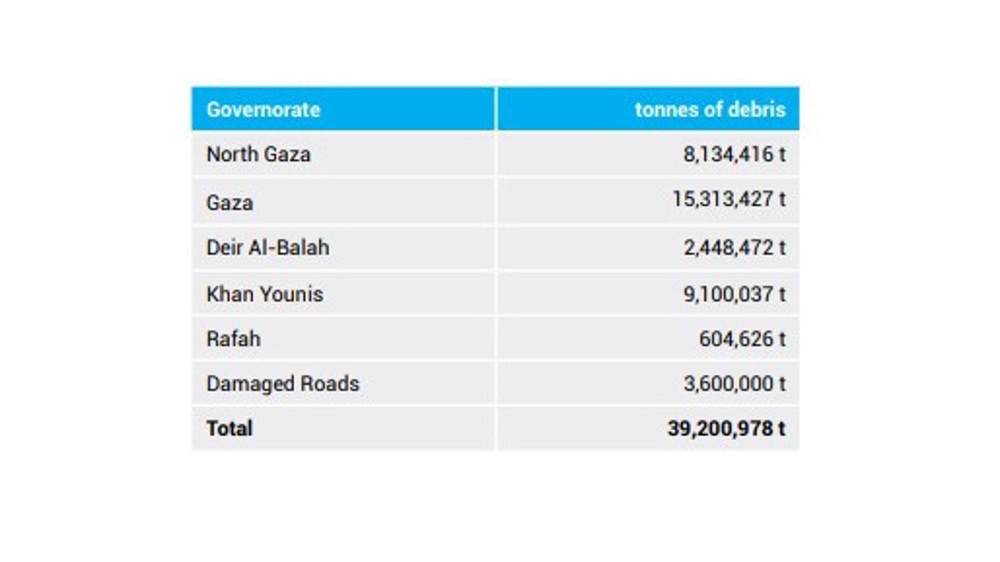
Conflict-related debris
In addition to heaps of uncollected waste piled around shelters and refugee camps, the Israeli regime’s carpet bombing of Gaza’s dense urban areas generates major quantities of debris, posing risks to human health and the natural environment.
“Debris arises from damaged buildings and infrastructure and includes building materials such as concrete, bricks, furnishings, personal belongings, and other wastes,” UNEP’s preliminary assessment stated.
"Conflict debris differs from normal construction and demolition waste in that it contains unexploded ordnances and human remains, and it is released in an uncontrolled manner impacting a wider area.”
The Geneva-based human rights group, Euro-Mediterranean Human Rights Monitor, reported earlier this month that more than 10,000 Palestinians are missing under the rubble in Gaza, “with no way to recover them or properly bury their remains.”
“Since most of the victims’ bodies have already decomposed, the Israeli policy of obstructing and impeding their recovery plays a significant role in the spread of fatal illnesses and epidemics in the Gaza Strip,” it said.
Also, according to the joint Interim Damage Assessment (WB, EU, and UN 2024) as of the end of January 2024, more than 60 percent of the physical infrastructure in all sectors in Gaza, except WASH (water, sanitation, and hygiene), had been damaged or destroyed.
Approximately 62 percent of all homes in Gaza have been damaged or destroyed, equivalent to 290,820 housing units. Transport sector damages amount to around US$358 million, affecting 62 percent of roads, including 92 percent of primary roads, and a significant proportion of vehicles.
UNEP’s regular quantification of the debris generated from the Gaza war shows that by May 2024, the amount was estimated at over 39 million tons.
So far, the amount of debris in Gaza is 13 times more than the combined sum of all debris generated by other wars in Gaza since 2008. For each square meter in the Gaza Strip, there is now over 107 kg of debris, which may contain UXO, hazardous substances, and human remains, it highlighted.
The debris itself constitutes a physical barrier in terms of access and safety risk with major implications on the delivery of humanitarian relief and the return of internally displaced persons, UNEP revealed.
Also, components of the debris can contain harmful substances including asbestos, heavy metals, fire contaminants, UXOs, explosive residue, household chemicals, and other hazardous substances.
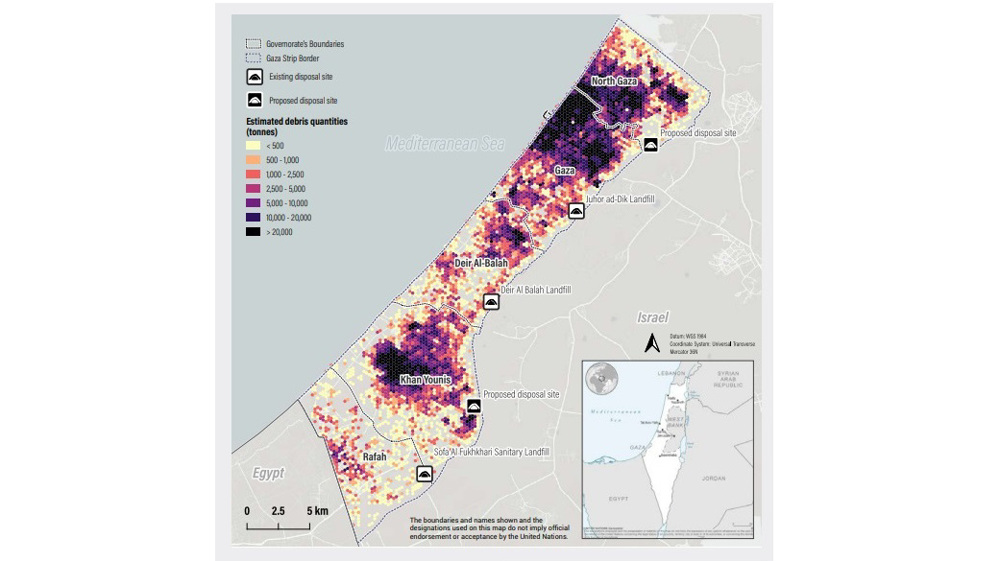
Dust is another significant concern associated with debris, the inhalation of which over time can cause lung diseases and due to its lightweight and particulate nature it spreads easily.
Wind and rain may carry contaminants in the dust into the soil, groundwater, and coastal waters, potentially causing impacts to spread beyond the site of original damage or in locations where debris has been disposed of, the report stated.
According to the WHO, asbestos fibers in the air cause lung cancer, mesothelioma, larynx and ovarian cancer, and fibrosis of the lungs, also called asbestosis.
Based on a rapid analysis of the debris generated in refugee camps by related UN bodies, it is estimated that around 800,000 tons of debris may be contaminated with asbestos and would need to be handled as hazardous waste.
Depending on whether the disposal or recycling option for the debris is pursued, UNEP estimates that preliminary scenarios on the cost of managing the 39 million tons of debris range from around $647 to $513 million.
“So much fuel, water, and construction material were used to erect those buildings in Gaza and now that they are razed to the ground collecting and disposing the debris can negatively affect the environment,” Abbas Mohammadi, a pro-Palestine environmental activist told the Press TV Website.
“So much more water, fuel, and building materials must be used for reconstruction of the urban spaces which could result in depletion of millions of cubic meters of water,” he added.
Fuel spills, lead pollution
Damage caused by Israeli bombardment of facilities that run on fuel can potentially lead to spills into soil, groundwater, and the sea, the UNEP report stated.
Fuel fires release not only soot, toxic compounds, and climate gases, but are also hazardous and challenging to extinguish, it added.
Also, the use of solar technology in Gaza means that debris from damaged and destroyed panels, along with the by-products of their combustion, now poses new environmental hazards.
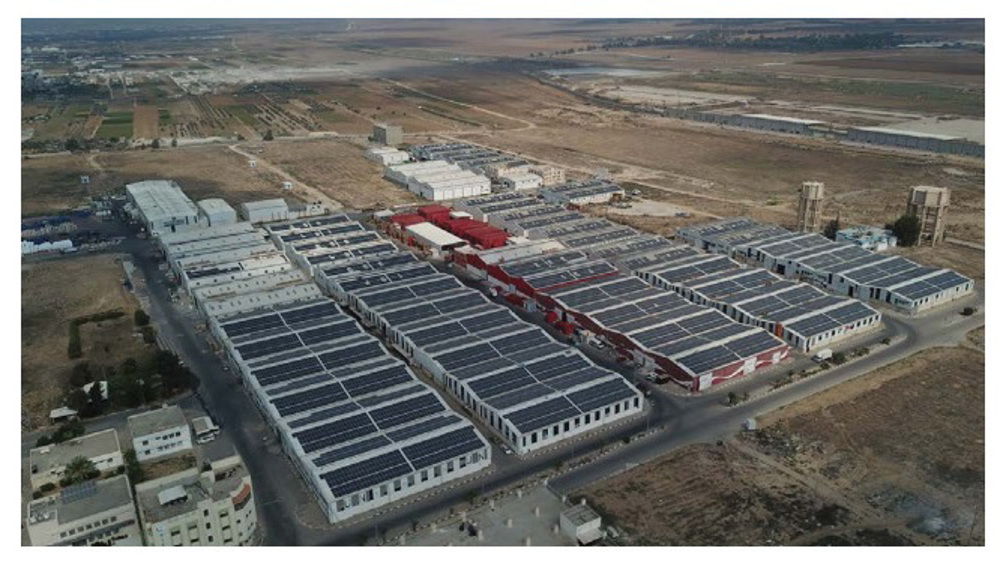
The destruction of 67 MW of solar photovoltaic systems (industrial, commercial, and residential, including the PV cells and batteries), has contributed to the release of hazardous material into the environment, including an estimated 1,675 kg of lead, preliminary data obtained during the preparation of the Interim Damage Assessment stated.
When the panels are compromised or burned, toxic substances such as lead and cadmium, found in the panels, can leach into the soil and water sources.
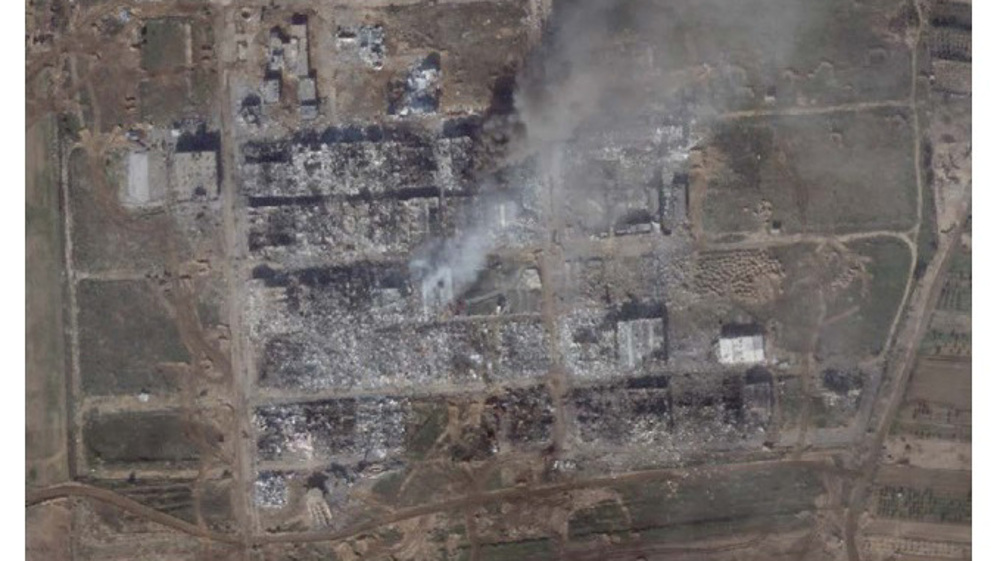
Additionally, the burning process releases hazardous chemicals and heavy metals into the environment, contributing to air pollution with potentially toxic fumes from plastics and other synthetic materials used in panel construction.
These emissions and contaminations pose immediate health risks to the population through inhalation and long-term ecological damage by polluting drinking water supplies and agricultural land.
Marine, coastal environments, and fisheries
Israel’s war on Gaza has almost certainly led to an increase in marine pollution from sources including untreated sewage, solid waste, and munitions, UNEP noted in its preliminary assessment while clarifying that the testing of marine waters off Gaza is not possible at the moment.
Pathogens associated with sewage-contaminated coastal waters can cause severe illness in humans.
Recovery of natural flora and fauna from ongoing chronic sewage pollution of coastal waters necessitates a 10–25 years cessation of pollution input, the assessment added.
UNEP explained that while fishing was an important source of food and provided direct livelihoods to approximately 3,700 people in Gaza in 2023 it may now be affected by marine pollution as well as by the physical destruction of the Gaza fishing fleet.
Soil and farmlands polluted, damaged
Analysis of the Food and Agriculture Organization of the United Nations (FAO) data to mid-February indicated that 42.6 percent (6,694 ha) of all cropland in Gaza has been damaged.
The World Bank in March recorded substantial destruction in the agricultural sector, estimated at US$629 million, related to the destruction of trees, agricultural holdings, greenhouses, retail establishments, and irrigation infrastructure.
Damage to the agricultural land, soil, livestock, and trees will impact food production and security, UNEP says.
“Considering the intensity of the bombardment, it is highly likely agricultural soils in Gaza are contaminated with heavy metals and other chemicals associated with military equipment and munitions. This type of impact has been recorded in previous conflicts.”
Satellite analysis showed in late March that about 38-48 percent of tree cover and farmland in Gaza had been destructed.
In addition to the direct destruction from Israel’s relentless bombing, the regime’s ban on fuel to Gaza has led people to cut down trees wherever they can find them to burn for cooking or heating.
“It’s whole orchards gone, only soil left; you don’t see a single thing,” He Yin, an assistant professor of geography at Kent State University in the US, said.
According to Mohammadi, with Gaza farmers being unable to access their lands for more than 9 months and relentless bombardments of the area, “it is safe to say that all agricultural lands are completely destroyed by now.”
One study that analyzed the impact of warfare on the desert environment, soil, native vegetation, and other natural resources of Kuwait found that conflict impacts persisted even after 18 years, and in some cases, their hazard potential increased.
Intense summer heat
While the earth has broken temperature records for 13 consecutive months, according to the Copernicus Climate Change Service, the war-battered 2.3 million population of Gaza, forcibly displaced and living in tents and over-crowded shelters face greater climate-related risks.
Euro-Med Human Rights Monitor reported that summertime’s sharp rise in temperature, coupled with high humidity, dry weather, and the proliferation of insects and rodents, poses a major risk to displaced Palestinians in the Gaza Strip.
“Living in tents or overcrowded shelters under appalling environmental and health conditions, displaced Palestinians are left to face their fate alone as they are exposed to excessive heat and scorching heat waves,” the rights group said.
“An unusual heatwave … made the already inhumane living conditions even worse for 1.5 million people, mostly living under plastic sheets in Rafah,” UNRWA chief Philippe Lazzarini said in a statement.
The intensity of heat waves and the spread of various illnesses among residents also killed people, including young children.
Malak Saed Al-Yazji, a 5-month-old infant died on April 25 after her family was forcibly evacuated to the southern city of Rafah, where the family had to live in a nylon tent, Euro-Med Monitor reported.
“The extreme heat wave that struck the refugee camp, which was devoid of basic supplies like water, and the resulting physical stress and trauma destroyed the baby’s health,” it added.
Lara Grace Al-Sayegh, 19, also died on April 25 because of the extreme heat. Al-Sayegh was attempting to escape from Gaza City to Rafah. At the time of her death, her mother was in a coma due to the same reason, the rights group noted.
Temperatures reportedly exceeded the seasonal norm by as much as 13°C in Gaza; the thermometer had reached 40°C on April 25.
WHO warned last month that scorching heat in the Gaza Strip could exacerbate health problems for Palestinians displaced by Israeli bombardment.
Other environmental hazards
Less immediately visible environmental challenges include the contamination of land, water resources, and the air by munitions and unexploded ordnance.
The Mines Advisory Group (MAG), a partner of the UN Mine Action Service, estimated in February that more than 25,000 tons of explosives have been used on the Gaza Strip since 7 October 2023, “equivalent to two nuclear bombs.”
Modern armed conflicts use large quantities of munitions containing heavy metals and explosive chemicals, all toxic even in modest quantities, UNEP said in its report.
Also, contamination of soil and water resources can arise from the recent destruction and flooding of Gaza tunnels by the Israeli military, the assessment said.
“If large quantities of seawater were pumped into an extensive network of tunnels, two effects might be expected which could be of concern: contamination of groundwater below the tunnels and potential instability of the area above the tunnels.”
“This life is not life,” says Abu Diab, who was displaced from Gaza City. “There is pollution everywhere – in the air, in the water we bathe in, in the water we drink, in the food we eat, in the area around us.”
Reversal of environmental impacts of war
The UNEP spokesperson told the Press TV Website that reversing the environmental impacts of the war “depends on many variables, including the governance and security arrangements that will exist in a post-war period and the levels of funding made available for recovery.”
“Further assessments would be required to understand the extent of damage and the impacts this has had, and will continue to have, on the environment and human health,” the spokesperson stressed.
According to Inger Andersen, UNEP Executive Director, the Gaza war’s environmental damages are “deeply harming people’s health, food security and Gaza’s resilience.”
“While many questions remain regarding the exact type and quantity of contaminants affecting the environment in Gaza, people are already living with the consequences of conflict-related damage to environmental management systems and pollution today.
“Not only are the people of Gaza dealing with untold suffering from the ongoing war, the significant and growing environmental damage in Gaza risks locking its people into a painful, long recovery."
Mohammadi told the Press TV Website that Israel’s genocidal war against Gaza seems to be a planned action to deplete this territory of any signs of life so no one can live there anymore.
“In my view, Israel is intentionally and systematically trying to drain life out of the Gaza Strip,” he said.
“What Israel is doing in Gaza is actually an ecocide: apparently they have planned to deplete this territory of any signs of life so no one can live there anymore or in case people choose to live there they should suffer the harshest consequences,” he added.
IRGC intelligence forces bust Takfiri terrorist team in western Iran
Syria’s de facto new ruler names Asaad al-Shibani as foreign minister
How 8-year-old Lebanese child Fawaz nixed Ben Gurion’s 76-year-old fallacy
VIDEO | 700,000 Cubans rally at US embassy in Havana against trade embargo
Iranian embassy staffer assassinated by terrorists in Damascus
VIDEO | Press TV's News Headlines
Scandalous detention of Iranians by US to extort information
VIDEO | Israeli forces open fire on Syrians protesting occupation


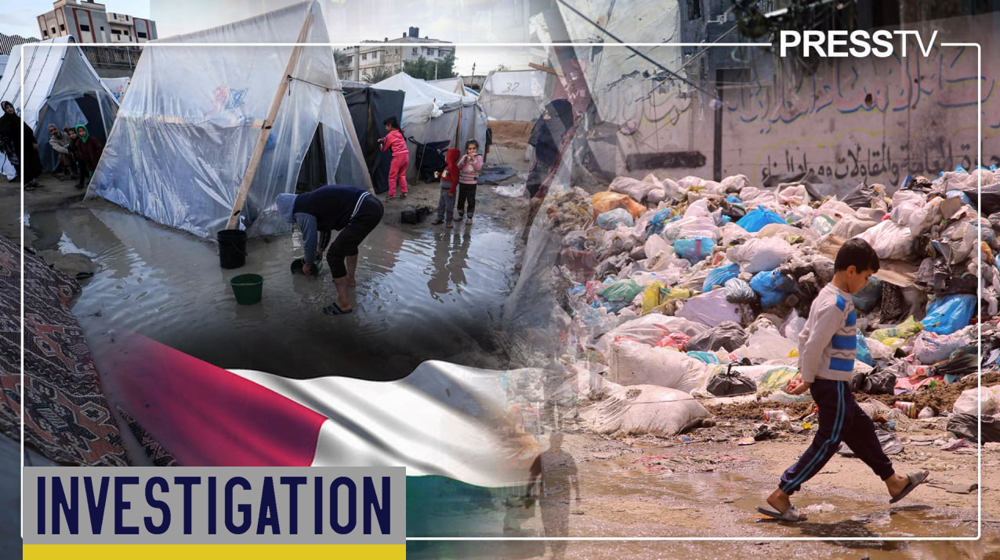


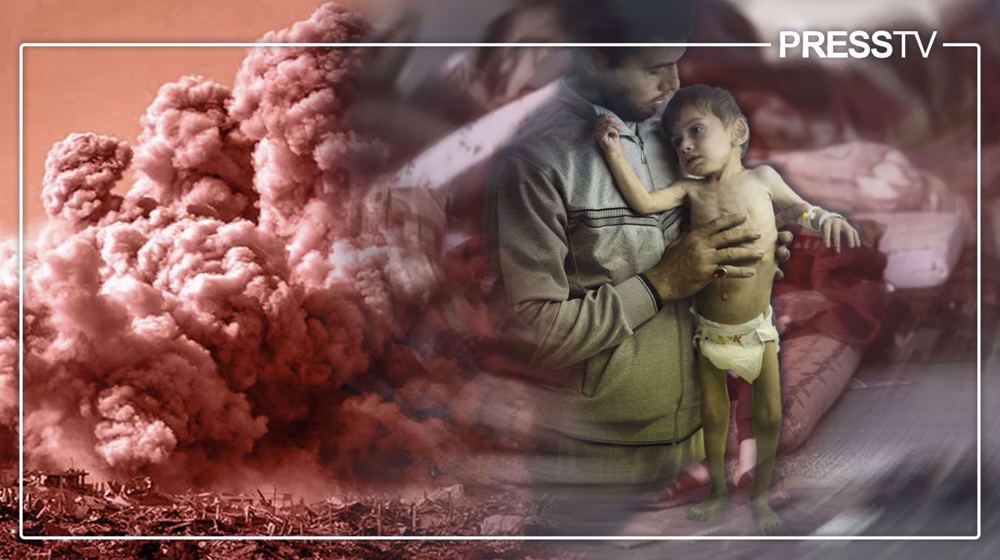


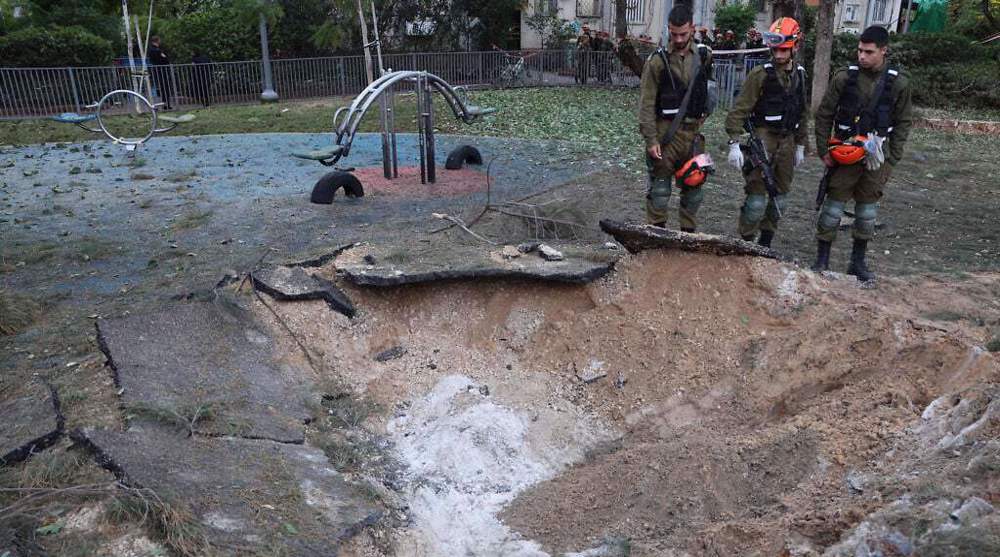




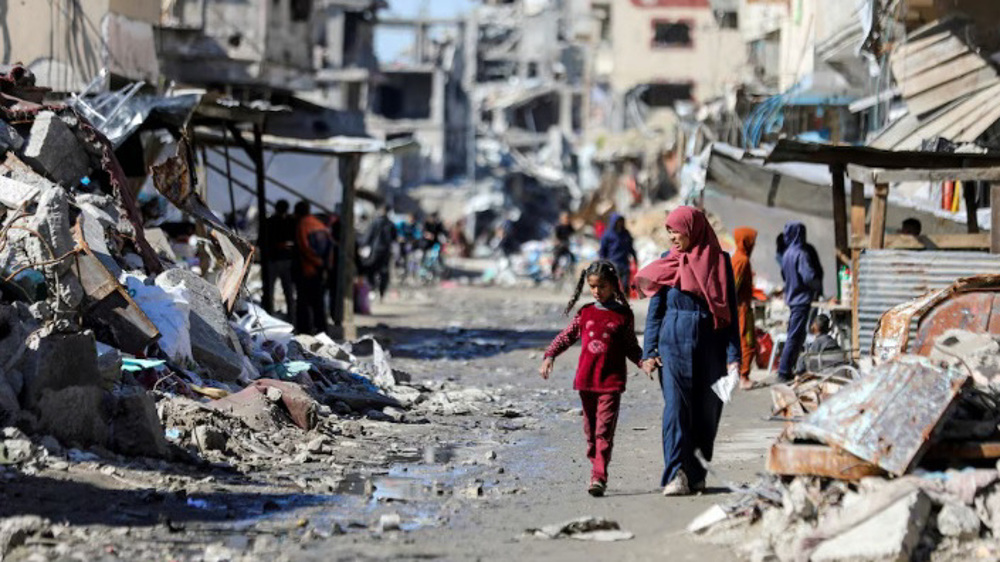


 This makes it easy to access the Press TV website
This makes it easy to access the Press TV website